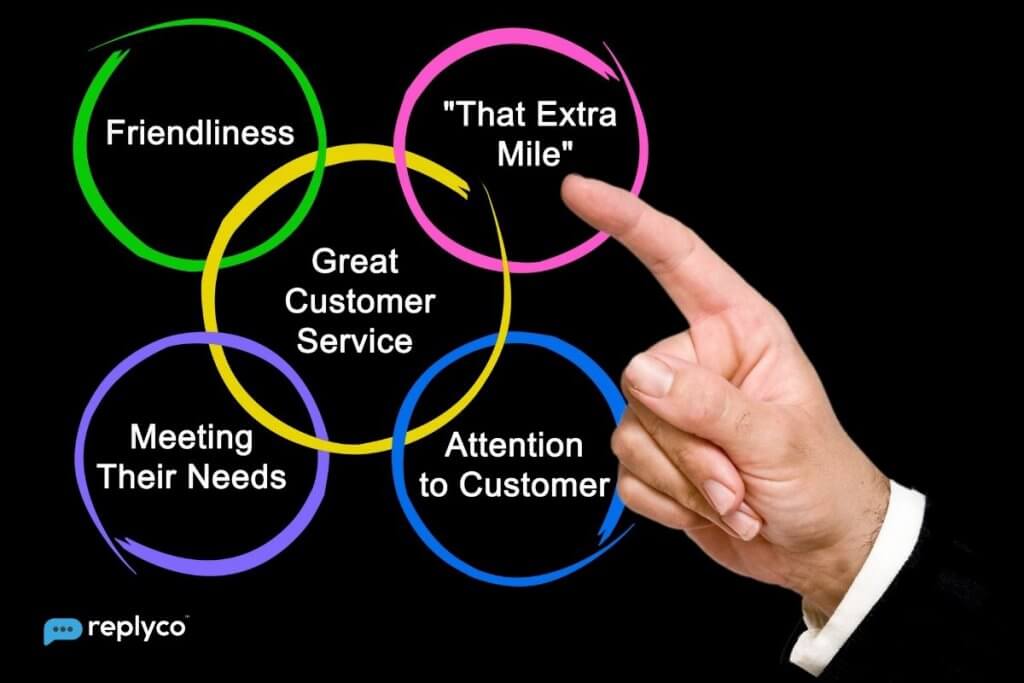25 Rules for Great Customer Service: Your Step-by-Step Guide

We’ve compiled data from tons of resources to list the top 25 rules for great customer service. Here’s your ultimate guide.
Here at Replyco, we eat, sleep and breathe customer service. It’s at the center of everything we do. And if you’re a retailer or eCommerce seller, it should also be at the center of everything you do.
That’s because the success of just about every kind of business depends on the quality of its customer service. The strategy is simple: keep customers happy, and they’ll keep coming back to your store (or business).
We have created several guides and articles surrounding the topic of customer service, but it can be overwhelming to figure out exactly what you need to do in order to perfect your strategy. So, we’ve distilled droves of research, insights and data from our own past content as well as dozens of other sources into one step-by-step guide. Here are the top 25 rules for offering great customer service.
1. Be Respectful, Courteous & Helpful

Good customer service starts with your demeanor. Approach each and every interaction with a respectful, courteous and helpful attitude.
This tactic will start your conversations on the right note, and can even help to dispel some of a customer’s frustration before you even begin to offer a solution. You should also make sure to remain friendly and cordial throughout the entire interaction, no matter the situation.
2. Pay Attention to Your Customers
Next, pay close attention to the customer with whom you’re speaking (or messaging). Don’t spend your time trying to think of what to say next, or else you won’t really be listening to what they’re saying.
Instead, actively listen as the customer explains their question or issue. This shows them that you care about their experience, value their time and are eager to provide the best resolution possible.
3. Ask the Right Customer Service Questions
Once your customer has finished explaining their inquiry or problem to you, it’s time to respond. But sometimes, you need more information in order to properly address the situation.
If you’ve paid close attention to the customer’s queries and / or comments, then you’ll be well-equipped to ask the right questions so you can effectively get to the heart of the matter.
4. Get Things Done
After listening to your customer and asking the right questions to determine the best path forward, you need to provide a solution.
Sometimes, resolving a customer service need is simple. Maybe they just want to return an item or inquire about when their order will be delivered. Other times, the customer’s needs or the issue itself may be more complicated (such as a complaint or a question to which you don’t know the answer).
The important thing here is to get things done for your customer. If you need to consult with another member of your staff (or even an outside courier or vendor) to find an answer, do it. And if the problem is going to take some time to resolve, be honest with your customer about it. We’ll have more on all of these concepts later, but just remember: once you’ve spoken with your customer and determined their question or need, handle it to the best of your ability.
5. Prioritize Customers’ Wants & Needs

Now that we’ve gone through the basic steps of how to handle an interaction, let’s look at the ways in which you can provide the very best customer service. We’ll start with one of the most important facets: always prioritize customers’ wants and needs.
This goes along with our first step. In addition to a friendly and courteous demeanor, you should approach every customer interaction with the genuine desire to address their needs.
6. Know Your Audience
In order to be able to meet customers’ wants and needs, you need to understand what they are. So do whatever you can to get to know your audience.
What are shoppers who might buy your products looking for? Depending on what you sell, you might cater to consumers who work in certain industries or prefer specific styles. Use things like demographic research, online forums, reviews, frequently asked questions, buyer habits and the like to really learn about your customers.
7. Understand Your Products
And to best answer any questions your customers or prospects may have, you should also gain and maintain a full understanding of your products or services.
Like with all of the steps in this guide, this strategy also applies to anyone on your staff who handles customer service. Your entire team needs to have a thorough working knowledge of everything your company sells.
8. Put Yourself in Their Shoes
If you want to provide truly great service to your customers, put yourself in their shoes. Think about the kinds of resolutions or answers you would want if you had the same issues or questions.
Another way of saying this is to have empathy for your customers. By being able to relate to their needs and / or frustrations, you can offer much more compassionate support and thoughtful solutions.
9. Go Above & Beyond to Provide Good Customer Service
Companies that are renowned for having the best customer service go above and beyond to provide solutions. As we’ve mentioned, sometimes a customer’s question or need is easy to address. But there are other times when the situation calls for extra effort or creativity.
Do whatever you need to do (within your ability) to take care of each and every customer. We know you’re busy, but a big part of this is to also focus all of your attention on the matter at hand before moving on to the next call or message. Give each customer your undivided attention and go the extra mile to leave them satisfied. Your work will most likely be rewarded with excellent retention numbers, more sales, positive reviews and plenty of other benefits.
10. Don’t Make Promises You Can’t Keep

Here’s another big one. Don’t make promises you can’t keep. There’s an old saying, “It’s better to under-promise and over-deliver.” And that concept is especially true when it comes to customer service.
If a customer calls in with something they are already frustrated about, and you promise them a solution and then fail to deliver on it, they are going to be even more upset. This can make your company seem both inept and dishonest. That’s why it’s important to only guarantee things that you are absolutely certain you can provide.
11. Avoid Arguing
And while we’re on the subject of things not to do, never, ever argue with a customer. We know customer service is a difficult job, and sometimes you spend your entire day communicating with people who are annoyed or unhappy about something. But it is crucial that you maintain a friendly, helpful demeanor at all times.
As we’ve stated before, keeping your attitude courteous can even help to defuse a potentially negative situation. But even at the very least, this approach will help you avoid fighting with or being rude to your customers.
This step goes back to the importance of putting yourself in your customer’s shoes. Try to understand why they might be frustrated, let them know that you empathize with them and do what you can to steer the conversation away from the complaint side and toward finding a workable solution.
12. Hire the Best Customer Service Reps
If you want to offer the best customer service in your industry, then you need to hire the best reps. Make sure every customer service representative on your team is capable of following the steps in this guide, as well as any protocols your company implements.
If you want to know more about how to hire amazing customer service employees, check out our full-length guide on the subject.
13. Have Enough Customer Service Staff
It’s not just enough to have the right employees, you also need to hire enough of them to adequately handle your company’s customer service workload.
The number of people you need will depend on the size of your company and the number of inquiries you receive on a regular basis. Make sure you have enough people on hand to efficiently and effectively take care of customer needs without being too overloaded or allowing any messages to fall through the cracks. You may also need to bring on extra seasonal workers for busy times, such as holidays or weeks when your full-time staff members are on vacation.
14. Train & Talk to Your Team
And once you have the right team in place, you need to train them well and communicate with them regularly. This can help keep everyone on the same page when it comes to expectations and protocols for providing amazing customer service.
Frequent team meetings are one way that you can keep your staff apprised of everything that is going on and needed, but there are other things you should do as well. For instance, if you use messaging software to handle customer inquiries, utilize tools such as internal notes to keep records of customer interactions. That way, if a customer is helped by more than one person, everyone will know what has happened with the conversation so far.
15. Tell the Truth

We’ve mentioned this already, but it requires its own step. Always tell your customers the truth. Even when a situation is less than ideal, lying or hiding the full truth from customers will only serve to make your company appear dishonest or shady.
Sometimes, there are things outside of your control, such as recent shipping delays amid COVID. Other times, someone on your team may have made a simple mistake, like shipping the wrong item to a customer. But no matter what has happened, be honest and open with your shoppers and then do whatever is in your power to make things right.
16. Follow Up After Customer Service Interactions
This step is one that occurs after the initial customer service interaction has ended, but it’s no less important. Any time you’ve provided service to a customer, be sure to follow up with them afterwards.
Your follow-up approach can be as simple as a “How did we do?” email, or it can involve an actual phone call. You can even include a survey in your follow-up correspondence so customers can provide you with feedback. The point is, you need to reach back out and make sure the customer received the support they needed and expected.
Following up also allows you to gain useful insights into how well your customer service approach is working, so you can update your strategies as needed. Or, if a customer is still unsatisfied, following up gives you the opportunity to try another solution for them.
17. Show Appreciation
On that same note, always show appreciation to any customer who has reached out to you. Thank them for giving you the opportunity to earn or keep their business and address their needs.
This appreciation should be evident in every part of your communications. For example, when getting on a customer service call or responding to an email, your first words should be, “Thank you for calling / emailing…” And then part of your conversation wrap up should include, “Thank you; have a great day.”
18. Upgrade Your Customer Service Regularly
Use any feedback you receive during interactions or when following up to upgrade your customer service strategies regularly. If something isn’t working, change it. If something is working, see what you can do to make it even better.
For example, are customers responding particularly well to a specific solution? Look into the situation and determine what it is that is delighting shoppers to such an extent and see how you can duplicate that success. On the flipside, if customers are having the same problem over and over, see what you can do to prevent the issue from occurring in the first place.
19. Ask How You Can Improve Customer Service
And if you want more information on how you can improve your customer service approach, ask your customers! You can ask for feedback during customer service interactions, when you follow up afterwards or even in a pop up form on your website.
20. Let Customers Serve Themselves

We covered the latest ways in which customer expectations have changed in a recent guide, and found that today’s shoppers are eager to serve themselves. You can actually reduce the number of customer inquiries you receive while keeping shoppers even happier by providing ways for them to find their own answers and solutions.
Do this by offering FAQ pages, help docs, knowledge bases and the like right on your website. By helping shoppers find what they’re looking for easily, you are encouraging them to complete their purchase (while also giving them a great shopping experience).
21. Maintain a Social Media Presence
If you really want to know what customers are looking for, you need to maintain a social media presence. By doing so, you can learn more about any online conversations that are relevant to your industry. Social media is also a great way to answer any questions customers are asking about your products, brand or industry that you might not have seen otherwise.
22. Prevent Customer Service Issues Ahead of Time
You can also use the information you gather from various types of research to prevent issues ahead of time, thereby decreasing the number of customer service calls / complaints you receive.
Data from customer service interactions, follow-up conversations, demographic research, social media networking and the like can all help you make improvements to your business practices that mitigate problems before they even occur.
23. Set Realistic Customer Service Expectations
As we wrap up with the last few sections of this guide, let’s talk about one really crucial piece of your customer service strategy. You need to be realistic in your expectations, both of yourself and of your team.
Not every customer service interaction is going to go perfectly. Some customers are going to walk away upset no matter what solutions you offer. And other times, the mistake may be the fault of someone within your company. Accept the fact that people make mistakes, and no strategy can work exactly right 100% of the time.
Yes, it is important to require the highest level of effort from everyone on your staff. However, you also need to set attainable goals and give people a break every now and then. Finally, recognize anyone on your team when they’ve performed especially well. Thank and reward your employees for their hard work, and you will be encouraging a positive company atmosphere. This will most certainly also result in better performances all around.
24. Be Easy to Reach
Now on to the last two. These all have to do with being a good communicator. First of all, be easy to reach.
If a customer has a problem or question, they shouldn’t have to search around for how to contact you or wait on hold forever. Provide your contact information in an easy-to-see spot on your website and be available during the business hours listed for your company.
25. Never Leave Any Customer Hanging

Finally, this may be the most important one. Never leave any customer hanging. Even if you receive a message with a question you don’t know the answer to, get back to the customer as soon as possible. Let them know that their inquiry and time are valued, and that you are working on the issue.
There are two ways customers are often left hanging. The first is when they fall through the cracks completely (when a busy seller somehow misses their inquiry altogether). And the second is when a seller just takes too long to get back to them.
Both of these pitfalls can be avoided by using a helpdesk solution such as Replyco to get a handle on customer messages. By centralizing all of your messaging into one easy-to-use inbox, you can make sure that no customer ever goes unanswered. And tools such as live chat and smart auto-responders mean customers always receive a timely reply to inquiries even when you’re out of the office (enabling you to keep consumers happy until a human member of your team can fully address their needs).
Want to take control of your inbox immediately? Start your free, no-credit-card-required trial today!





